
Click on the image to see a PDF version (for zooming in)
Fig. 5.28. Long-range lateral connections in the combined OR/OD
map. The inhibitory lateral connections for four sample neurons
from the regions marked in Figure 5.27 are shown situated on the OR
preference and selectivity map (top) and the OD map (bottom) as in
Figures 5.12 and 5.17. The connection patterns on the OR map are
similar to those in the orientation-only map. The most selective
iso-OR neurons (a) are located near the OD stripe boundaries, and
receive connections equally from neurons of both eye
preferences. Neurons in iso-OR regions away from the OD boundaries
connect more strongly to one eye (not shown). OR fractures (b) and
pinwheels (d) tend to occur near the centers of OD stripes and receive
connections primarily from the same eye preference. Saddle points (c)
can occur either in the middle or near the boundaries of OD stripes,
and thus can have either monocular or binocular connection patterns;
the example neuron is in a monocular OD region and connects primarily
to the left eye. These connection patterns further extend the
predictions from Figure 5.12, showing how the connection patterns are
shared between the OD and OR maps.
|